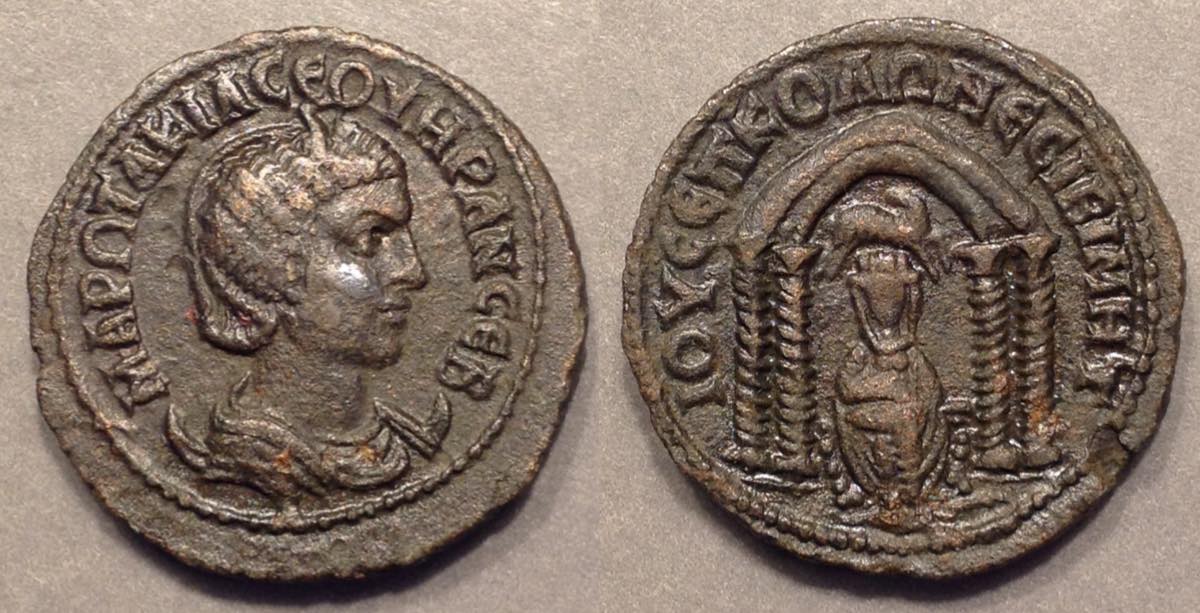 Otacilia Severa, wife of Philip I (Marcus Julius Philippus), who reigned 244-249.
Otacilia Severa, wife of Philip I (Marcus Julius Philippus), who reigned 244-249.
Roman provincial. 24.5 mm, 11.18 g.
Mesopotamia, Nisibis, AD 244-249.
Obv: MAP ΩTAKIΛ CЄOYHPAN CЄB,
(Marcia Otacilia Severa Sebasta)
diademed and draped bust right, on crescent.
Rev: IOY CЄΠ KOΛΩ NЄCIBI MHT,
(Julia Septimia Colonia Nisibis Metropolis)
[This "Julia" is a family name for Philip.]
Tetrastyle temple containing statue of city goddess seated facing; above her head, ram (Aries) leaping right, head turned back; below, river god Mygdonius swimming right.
References: Sear Greek Imperial Coins 4065. BMC 27. SNG Copenhagen 244. RPC VIII "unassigned; ID 2575."
Gordian III. Emperors from Macrinus to Gordian III also issued coins at Nisibis, but they are scarcer. Here is a large coin of Gordian III and Tranquillina with a design also issued for Singara. (For Singara the reverse legend has "CINΓAPA" instead of "ΝƐϹΙΒΙ".) It is likely coins of Singara and Nisibis were struck at the same mint.
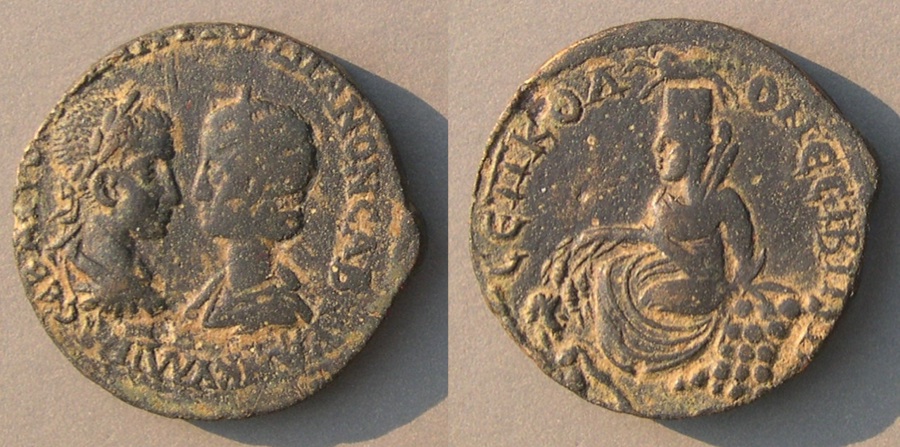 Gordian III (238-244) and Tranquillina
Gordian III (238-244) and Tranquillina
32 mm. 24.73 grams. This denomination is sometimes called a "provincial sestertius" because of its size.
The obverse legend begins at 8:30:
ΑΥΤΟΚ Κ Μ ΑΝΤ ΓΟΡΔΙΑΝΟΝ ϹΑΒ ΤΡΑΝΚΥΛΛΙΝΑ ϹƐΒ
Imperator Caesar Marcus Antonius Gordianus (et) Tranquillina Augusta
ϹƐΠ ΚΟΛ-ΟΝ ΝƐϹΙΒΙ ΜΗΤ
Septimia Colonia Nisibis Metropolis
City goddess seated left on rocks, holding ears of grain, ram running left above, river god (Mygdonius) swimming left below.
Almost all coins of Nisibis have some flaw or another. The coin above has the obverse legend crowded. The next coin is the same type with different problems.
 Gordian III (238-244) and Tranquillina
Gordian III (238-244) and Tranquillina
33 mm. 19.74 grams. Repatinated.
The obverse legend begins at 8:30:
ΑΥΤΟΚ Κ Μ ΑΝΤ ΓΟΡΔΙΑΝΟΝ ϹΑΒ ΤΡΑΝΚΥΛΛΙΝΑ ϹƐΒ
Imperator Caesar Marcus Antonius Gordianus (et) Tranquillina Augusta
Reverse: ϹƐΠ ΚΟΛΟΝ Ν-ƐϹΙΒΙ ΜΗΤPO [MH ligate]
Septimia Colonia Nisibis Metropolis
City goddess seated left on rocks, holding ears of grain, ram running left above, river god (Mygdonius) swimming left below.
History. Nisibis was made a Roman colony under Septimius Severus (hence the title ϹƐΠ for "Septimia" seen on some of its coins), but Roman provincial coins did not begin until Macrinus (217-218). Coins of Nisibis are scarce until Gordian III (238-244). Then they are common under emperor Philip (244-249) and his family, Philip II and Otacilia Severa--the last Romans to issue coins from Nisibis. Nisibis was lost to the Sasanians c. 250-252 under Shapur I. However, Nisibis was regained by Odenathus, ruler of Palmyra, in 262 and resumed being Roman and became, for almost another century, the main Roman trading contact with the Sasanaian empire. However, provincial coins were no longer being minted in the east. Mesopotamia was still being fought over as late as the time of Julian II (360-363). It endured invasions by the Sasanians in c. 338, 346, and 350, before it was terminally ceded to the Sasanians upon the retreat of Jovian (363-364) immediately after the death of Julian.
The siege of c. 338 is particularly interesting. The Sasanaians tried the usual siege techniques. They attempted to demolish or scale the walls. They tried to undermine them with tunnels and collapse them by firing the tunnel supports. After failing for over two months, Shapur II had his army construct dams to redirect the river Mygdonius (the river god is on some of the coins) to flow against the walls and erode them. Part of the wall collapsed, but an assault was not possible until the river had been redirected away and the mud became passable. The defenders used the time and the rubble to build additional fortifications inside and held off the assult. Shapur II gave up.
A.H.M. Jones, in The Cities of the Eastern Roman Provinces, writes "... Lucius Verus annexed Mesopotamia. The Parthians did not acquiesce in the loss of the province, and further campaigns were required under Septimius Severus, Caracalla, and Macrinus to maintain the conquests of Verus. Then, early in the third century [AD 224], the Sassanian dynasty replaced the effete Arsacids [Parthians] and renewed the struggle for Mesopotamia with greater efficiency. Successive campaigns were fought by Severus Alexander, Gordian III, Philip, Valerian, Odenathus, and Carus.
"...Severus was certainly the founder of Septimia Rhesaina and Septimia Nisibis, which later took the additional title Julia [seen on coins as "IOVΛI"] in honor of Philip."
Jones continues "... Under Diocletian the Persian wars continued. ... Julian, after brilliant initial successes, was disastrously defeated and his successor Jovian (363-364) signed an ignominious peace whereby not only the greater part of Diocletian's conquests but [also] Nisibus and Singara, which had been in Roman hands since the days of Severus and perhaps Verus, were surrendered to the Persians."
 To the right: Shapur I (240-270), the Sasanian King who fought against Gordian III and Philip.
To the right: Shapur I (240-270), the Sasanian King who fought against Gordian III and Philip.
27 mm drachm. 4.46 grams.
Obverse: His bust right with mural crown distinguishing him.
Reverse: Fire altar with attendants on either side.
Reference: Sellwood 14, Göbl 23.
The (very good) book by Dodgeon and Lieu translates all the primary sources that mention conflicts between Rome and the Persia. Zonaras wrote that Carrhae and Nisibis had been taken in the reign of Maximinus (235-238). About Gordian III the Scriptores Historia Augustae says, "From there [Thrace] he marched through Syria to Antioch, which was then in the possession of the Persians. There he fought and won repeated battles and drove out Shapur, the king of the Persians, the successor of Artaxerxes. After this he recovered Antioch, Carrhae, and Nisibis, all of which had been included in the Persian Empire. " ... "Still in existence is an oration of Gordian to the Senate wherein, while writing of his deeds, he gives boundless thanks to his prefect and father-in-law, Timesitheus." SHA says of Timestheus, "but such Felicity could not endure. For as most say, all through the plotting of Philip, who was made prefect of the guard after him, or as others say because of a disease, Timestheus died, leaving the Roman state as his heir." Philip undermined Gordian with the soldiers and finally had Gordian murdered. He made peace with the Persians (Sasanians) at the cost of 500,000 denarii. This disgraceful event was recharacterized by Philip who minted Roman imperial coins claiming to have "founded peace with the Persians."
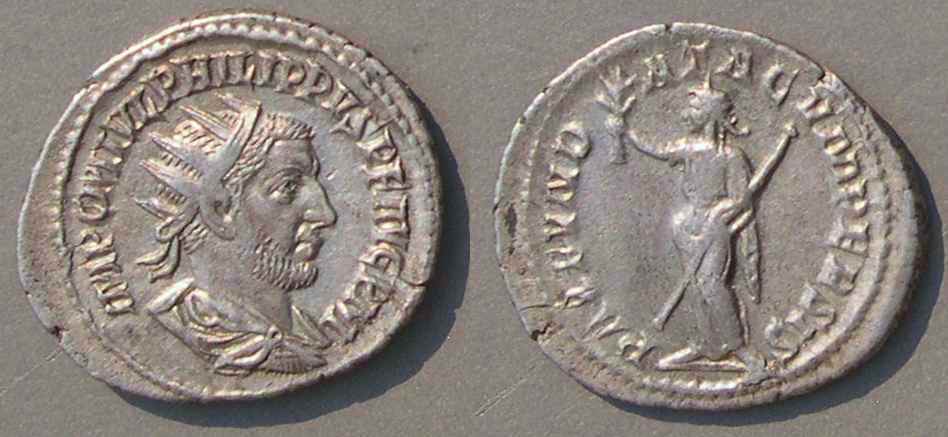 Philip I.
Philip I.
25-22 mm. 4.41 grams. An imperial "antoninianus."
IMP C M IVL PHILIPPVS PF AVG PM
Radiate bust right.
Reverse: Pax standing left holding up an olive branch in her right hand and holding a long scepter in her left hand.
PAX FVNDATA CVM PERSIS
"Peace founded with Persia"
In c. 250-252 Nisibis was catured by the Sasanians under Shapur I, which explains the lack of later Roman provincial coins from the city.
Nisibis was recaptured under Odenathus, ruler of Palmyra, in the time of Gallienus, but by then provincial coins were uncommon and not issued that far east. Aurelian recovered it for the central empire by defeating Palmyra in 274. A century later Shapur II failed to take Nisibis under Constantius II after three long and brutal seiges. But, after the death of Julian II (360-363) in battle in Mesopotamia it was ceded to the Sasanians under Shapur II by Jovian as part of the price of a safe retreat.
Other examples. Most examples have a four-column ("tetrastyle") temple, but some have six columns (one above) and some have a slightly different depiction of the columns (next) and some have a triangular pediment (second next), as opposed to the usual arched pediment.
 Philip I, 244-249
Philip I, 244-249
25-24 mm. 9.81 grams.
The same legends, but the temple columns are depicted differently.
Only the outer two colums are clear with their spiral decoration. The dots where the inner colums would be almost look like open doors.
Reference: RPC VIII on line 2824 . Columns like this are not illustrated there, but they are for Otacilia Severa as RPC 2975. RPC has only example among 56 with "the inner columns are decorated with dots."
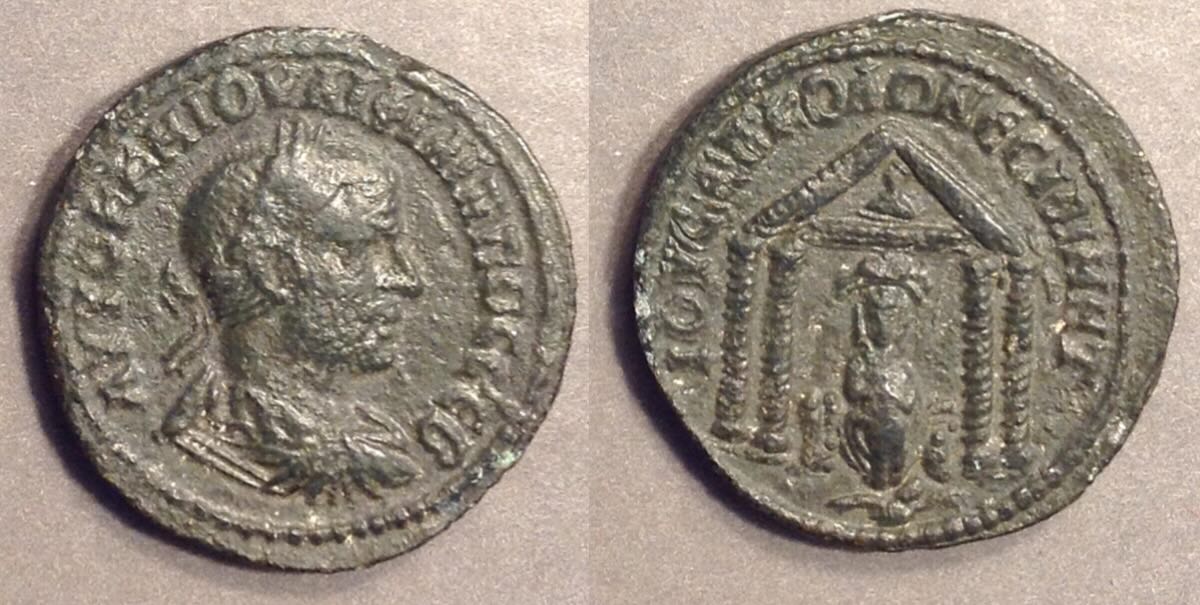 Philip I, 244-249
Philip I, 244-249
25.5 mm. 13.21 grams.
AVTOK K M IOVΛI ΦIΛIΠΠOC CЄB
Reverse: IOY CЄΠ KOΛΩ NЄCIBI MHT,
This variety has a triangular pediment. The others have an arched pediment. I think the temple had a trangular pediment, but the coins used an arched pediment to allow more room to display a larger goddess within the temple.
The next examples duplicate types above.
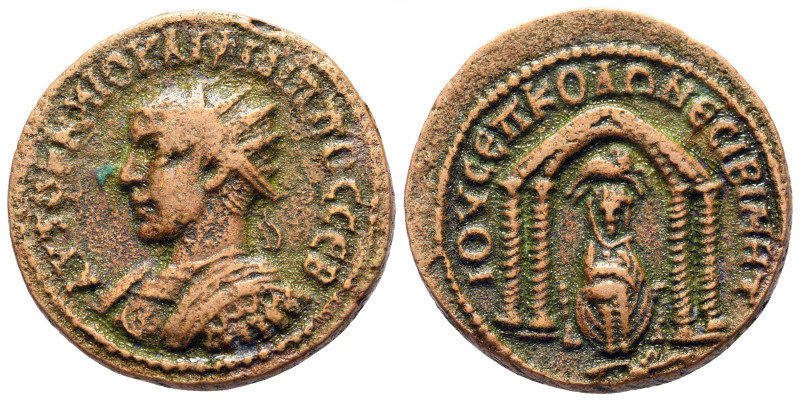
Philip II
25-24 mm. 10.70 grams.
AVTOK K M IOVΛI ΦIΛIΠΠOC CЄB
Reverse: IOY CЄΠ KOΛΩ NЄCIBI MHT
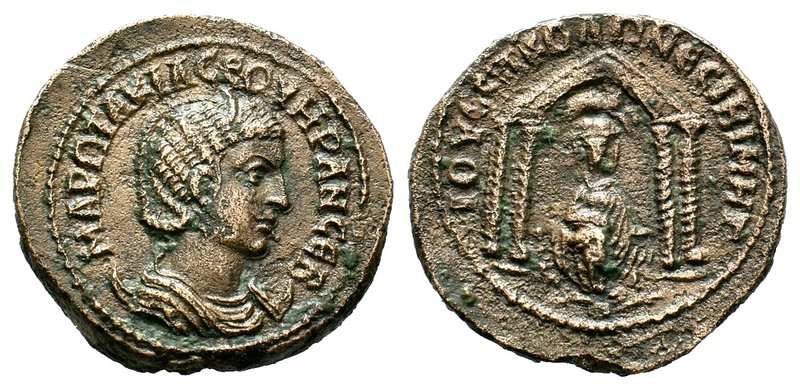 Otacilia Severa
Otacilia Severa
26-25 mm. 11.84 grams.
Obv: MAP ΩTAKIΛ CЄOYHPAN CЄB,
Rev: IOY CЄΠ KOΛΩ NЄCIBI MHT,
Conclusion. Nisibis (spelled "NECIBI" on the coins) figures in history books as a Roman city often under siege by the Persians (Parthians before AD 224 and Sasanians after 224). It had an extensive coinage for the family of Philip (Philip I, Philip II, and Otacilia Severa, 244-249) and some coins for Gordian III.
References.
Coin sources: BMC Greek, Mesopotamia. 1988. Of course, some coins of Nisibis are in SNGs (Danish, 12 pieces in volume VII. Righetti, 8 pieces. Lewis, 0 pieces. Hunterian, 9 pieces), but SNGs are all without commentary.
Butcher, Kevin. Roman Provincial Coins. A wonderful thin book which I love, but it has very little about Nisibis (what it has is on page 104).
Roman Provincial Coinage on-line: https://rpc.ashmus.ox.ac.uk/search/browse?volume_id=15&number=&city_id=667®ion_id=&province_id=&subprovince_id=&reign_id=&obverse_inscription_simplified=&reverse_inscription_simplified=&obverse_design=&reverse_design=&metal_id=&weight_min=&weight_max=&diameter_min=&diameter_max=&format=
[This is the best reference work for IDs and illustrations, by far.]
Books.
Dodgeon, Michael and Samuel Lieu, editors. The Roman Eastern Frontier and the Persian Wars, AD 226-363, A Documentary History. 1991. [431 page paperback of translated sources and commentary. Arranged chronologically. Very interesting. Read what ancient authors said about the conflicts, and learn when they wrote and what we now think about what they wrote. This book has many more mentions of Nisibis than the other books below. This book is both important and fun for understanding what happened in the east in that time period. Highly recommended!]
The next three are all very good (and large) books on the eastern regions of the Roman empire, but Nisibis is treated on very few pages.
Ball, Warwick. Rome in the East. 2001
Butcher, Kevin. Roman Syria and the Near East. 2003
Millar, Fergus. The Roman Near East: 31 BC - AD 337. 1993.
Internet.
Roman Provincial Coinage volume VIII on-line: https://rpc.ashmus.ox.ac.uk/volumes
with serarch results here:
https://rpc.ashmus.ox.ac.uk/search/browse?volume_id=15&number=&city_id=667®ion_id=&province_id=&subprovince_id=&issue_id=&reign_id=&obverse_inscription_simplified=&reverse_inscription_simplified=&obverse_design=&reverse_design=&metal_id=&weight_min=&weight_max=&diameter_min=&diameter_max=&format=
Wikipedia pages:
Nusayban https://en.wikipedia.org/wiki/Nusaybin
Roman-Persian Wars https://en.wikipedia.org/wiki/Roman%E2%80%93Persian_Wars
The Battle of Nisibis (217) https://en.wikipedia.org/wiki/Battle_of_Nisibis_(217)
The siege of Nisibis (252) https://en.wikipedia.org/wiki/Siege_of_Nisibis_(252)
Other web pages:
Strange War Tactics—The Sieges of Nisibis (337-350) https://thehistorianshut.com/2016/11/19/strange-war-tactics-the-sieges-of-nisibis-337-350-ce/
Go to the Table of Contents for this entire educational site.
 Roman Coins of Nisibis—a mini-theme.
Roman Coins of Nisibis—a mini-theme. 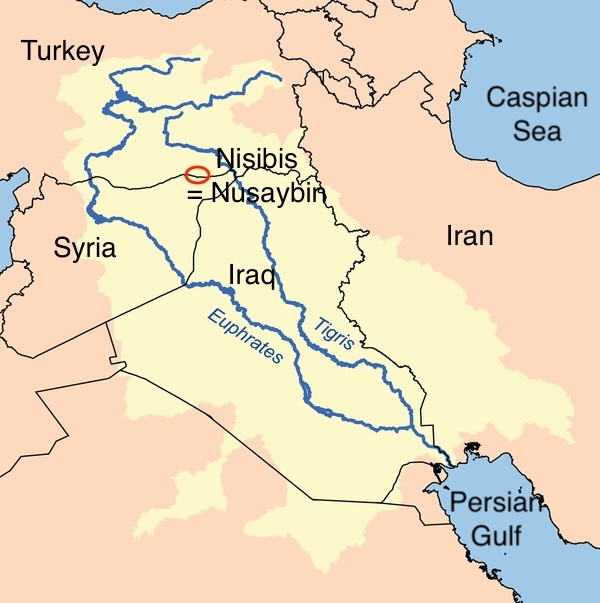

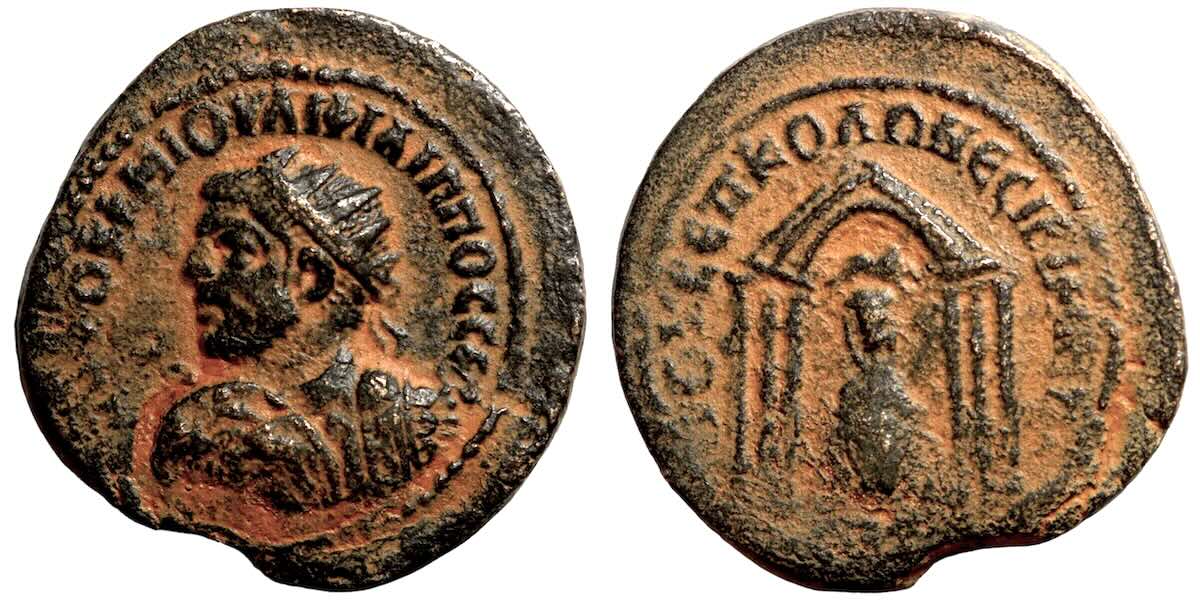








 Philip I, 244-249
Philip I, 244-249
